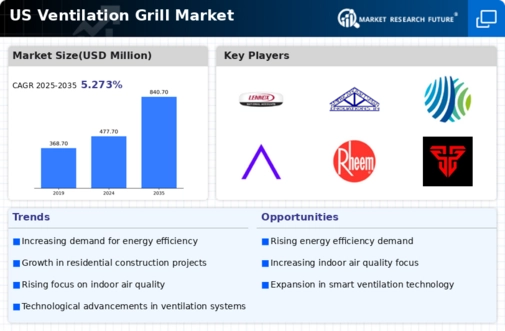Growth in Construction Activities
The robust growth in construction activities across the United States is a significant driver for the ventilation grill market. As new residential and commercial buildings are erected, the demand for effective ventilation systems becomes paramount. The construction sector is projected to grow at a rate of 5% annually, leading to an increased need for ventilation solutions that comply with modern building codes. Ventilation grills are integral components of these systems, ensuring proper airflow and temperature regulation. This growth in construction not only boosts the demand for ventilation grills but also encourages innovation in design and functionality, as manufacturers strive to meet the evolving needs of the market.
Rising Demand for Energy Efficiency
The increasing emphasis on energy efficiency in building designs is a primary driver for the ventilation grill market. As energy costs continue to rise, consumers and businesses are seeking solutions that reduce energy consumption. Ventilation grills play a crucial role in optimizing airflow, thereby enhancing the overall energy efficiency of HVAC systems. According to recent data, energy-efficient buildings can reduce energy consumption by up to 30%. This trend is particularly evident in commercial construction, where the demand for energy-efficient ventilation systems is projected to grow by 25% over the next five years. Consequently, manufacturers in the ventilation grill market are focusing on developing products that meet these energy efficiency standards, which is likely to drive market growth significantly.
Increased Focus on Indoor Air Quality
The growing awareness of indoor air quality (IAQ) is significantly influencing the ventilation grill market. With more individuals spending extended periods indoors, the demand for effective ventilation solutions has surged. Studies indicate that poor indoor air quality can lead to various health issues, prompting both residential and commercial sectors to invest in better ventilation systems. The ventilation grill market is expected to benefit from this trend, as these products are essential for maintaining optimal air circulation and filtration. In fact, The market for air quality improvement solutions is anticipated to expand by 20% in the coming years. This highlights the critical role of ventilation grills in enhancing IAQ and promoting healthier living environments.
Regulatory Standards and Building Codes
The implementation of stringent regulatory standards and building codes is a crucial driver for the ventilation grill market. In the United States, various regulations mandate specific ventilation requirements to ensure safety and health in buildings. Compliance with these standards is essential for construction projects, leading to an increased demand for ventilation grills that meet these criteria. The market is expected to see a rise in demand as builders and contractors prioritize compliance to avoid penalties and ensure occupant safety. This regulatory landscape not only drives sales but also encourages manufacturers to innovate and improve their product offerings to align with evolving standards.
Technological Advancements in HVAC Systems
Technological advancements in HVAC systems are reshaping the ventilation grill market. Innovations such as smart ventilation systems, which integrate IoT technology, are becoming increasingly popular. These systems allow for real-time monitoring and control of indoor air quality, making ventilation grills more efficient and user-friendly. The market for smart HVAC solutions is expected to grow by 30% over the next few years, indicating a shift towards more sophisticated ventilation options. As consumers seek greater control over their indoor environments, manufacturers are likely to invest in developing advanced ventilation grills that complement these high-tech systems, thereby driving market growth.





















Leave a Comment